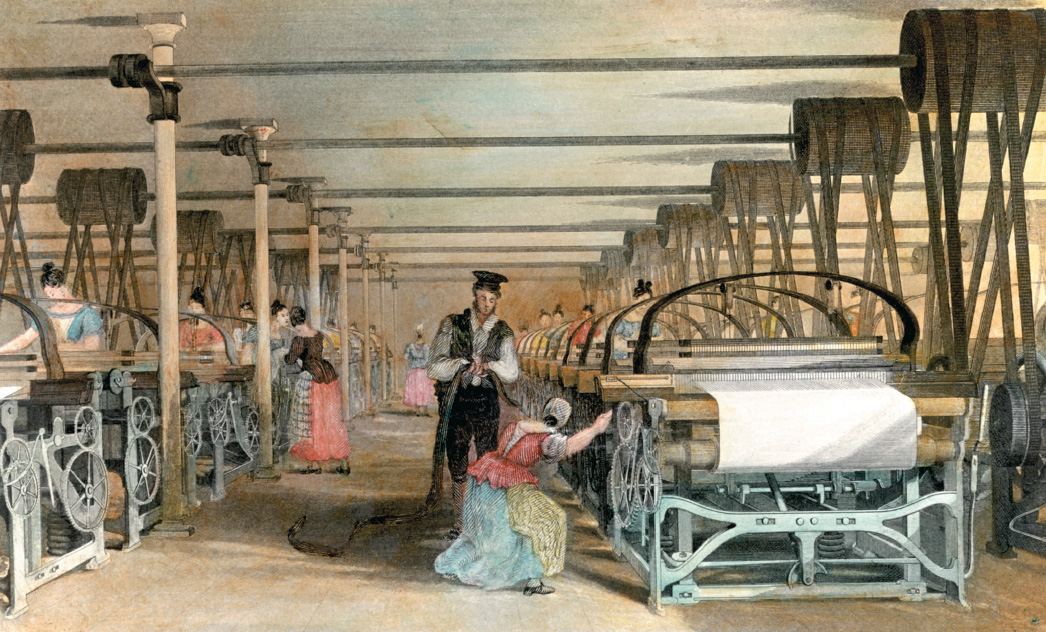Working Families and Children
By the 1790s the early pattern had begun to change. The use of pauper apprentices was in decline, and in 1802 it was forbidden by Parliament. Many more textile factories were being built, mainly in urban areas, where they could use steam power rather than waterpower and attract a workforce more easily than in the countryside. As a result, people came from near and far to work in the cities, both as factory workers and as porters, builders, and domestic servants. Collectively, these wage laborers came to be known as the “working class,” a term first used in the late 1830s.

In some cases, workers were able to accommodate to the system by carrying over familiar working traditions. Some came to the mills and the mines as family units. This was how they had labored on farms and in the putting-out system. The mill or mine owner bargained with the head of the family and paid him or her for the efforts of the whole family. In the cotton mills, children worked for their mothers or fathers, collecting scraps and “piecing” broken threads together. In the mines, children sorted coal and worked the ventilation equipment. Their mothers hauled coal in the tunnels below the surface, while their fathers hewed with pick and shovel at the face of the seam.
Ties of kinship were particularly important for newcomers, who often traveled great distances to find work. Many urban workers in Great Britain were from Ireland. They were forced out of rural Ireland by population growth and deteriorating economic conditions from 1817 on and their numbers increased dramatically in the desperate years of the potato famine, from 1845 to 1851 (see “Ireland and the Great Famine” in Chapter 21). As early as 1824 most of the workers in the Glasgow cotton mills were Irish; in 1851 one-sixth of the population of Liverpool was Irish. Pauper children were especially likely to be Irish, reflecting the precariousness of life for migrants. Like many other immigrant groups held together by ethnic and religious ties, however, the Irish worked together, formed their own neighborhoods, and not only survived but also thrived.
The preservation of the family as an economic unit in the factories helped people accommodate to the new surroundings during the early stages of industrialization. Parents disciplined their children and directed their upbringing. The presence of the whole family meant that children and adults worked the same long hours (twelve-hour shifts were normal in cotton mills in 1800). Adult workers were often complicit in the exploitation of their children. They were not particularly interested in limiting the minimum working age or hours of children as long as family members worked side by side and they maintained control of their young. Only when technical changes threatened to place control in the hands of impersonal managers did adult workers protest against inhuman conditions in the name of their children.
Some enlightened employers and social reformers in Parliament argued that more humane standards were necessary, and they used widely circulated parliamentary reports to influence public opinion. For example, Robert Owen (1771–1858), a successful manufacturer in Scotland, testified in 1816 before an investigating committee on the basis of his experience. He argued that employing children under ten years of age as factory workers was “injurious to the children, and not beneficial to the proprietors.”5 Workers also provided graphic testimony at such hearings as reformers pressed Parliament to pass corrective laws.
These efforts resulted in a series of Factory Acts from 1802 to 1833 that progressively limited the workday of child laborers and set minimum hygiene and safety requirements. (See “Primary Source 20.1: Debate over Child Labor Laws.”) The 1833 act installed a system of full-time professional inspectors to enforce the provisions of previous acts. Children between ages nine and thirteen could work a maximum of eight hours per day, not including two hours that must be devoted to education. Teenagers aged fourteen to eighteen could work up to twelve hours, while those under nine were banned from employment. The Factory Acts constituted a major victory in preventing the exploitation of children, especially those without families to protect them at the worksite. One unintended drawback of restrictions on child labor, however, was that they broke the pattern of whole families working together in the factory because efficiency required standardized shifts for all workers. After 1833 the number of children employed in industry declined rapidly.